Bill.com Bundle
How Did Bill.com Revolutionize Business Finances?
Ever wondered how a simple observation could spark a financial revolution? Bill.com, a leading financial operations platform, began its journey by identifying a critical gap in the market: while consumers embraced online payments, businesses lagged behind. This realization fueled the creation of a groundbreaking cloud-based solution designed to automate accounts payable and receivable, streamlining cash flow management for small and midsize businesses.
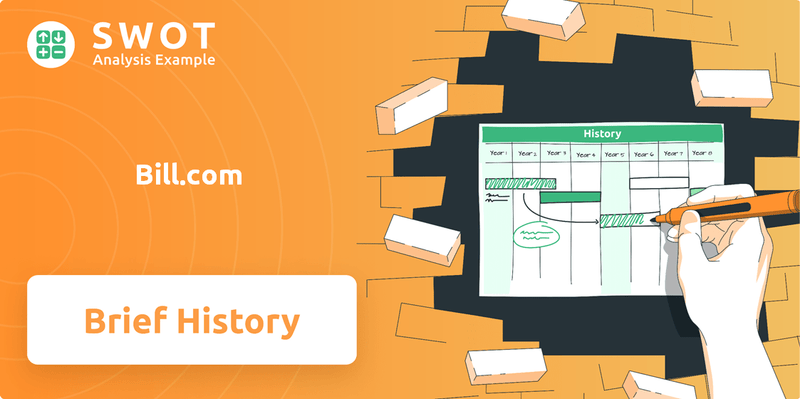
Founded in April 2006 by Bill.com SWOT Analysis founder René Lacerte, the company, initially named Cashboard, Inc., quickly evolved. From its inception in Palo Alto, California, Bill.com has grown into a publicly traded entity on the NYSE (BILL), serving nearly half a million businesses as of early 2025. This Bill.com company timeline showcases its impressive growth and impact on the fintech landscape, making it a key player in the industry. Understanding the Bill.com history is crucial for anyone interested in the evolution of business payments and the Bill.com business model.
What is the Bill.com Founding Story?
The story of Bill.com, a leading player in business payments, began in April 2006. Founded by René Lacerte, the company aimed to revolutionize how small and medium-sized businesses (SMBs) handled their financial operations. Lacerte's vision was to replace outdated methods with a secure, cloud-based platform.
Lacerte's experience in finance, software, and payments, including co-founding PayCycle, gave him a unique perspective on the inefficiencies of business payments. He saw a gap in the market and a need for a streamlined solution. This led to the creation of a platform that would simplify accounts payable and receivable.
The initial focus was on automating accounts payable and receivable for SMBs, enabling faster payments and receipts. Early funding, including a Series A round of approximately $8.5 million in 2007, helped fuel the company's growth. The acquisition of the domain name 'bill.com' from Marc Benioff further solidified its brand identity, setting the stage for its future success. Learn more about the company's core values and mission from this article: Mission, Vision & Core Values of Bill.com.
René Lacerte founded Bill.com in April 2006, initially named Cashboard, Inc., with the goal of modernizing business payments.
- Bill.com founder, René Lacerte, brought over 30 years of experience in finance, software, and payments.
- The company's early focus was on automating accounts payable and receivable for small businesses.
- Early funding came from venture capital, with a Series A round of about $8.5 million in 2007.
- The acquisition of the 'bill.com' domain name was a pivotal moment.
Bill.com SWOT Analysis
- Complete SWOT Breakdown
- Fully Customizable
- Editable in Excel & Word
- Professional Formatting
- Investor-Ready Format
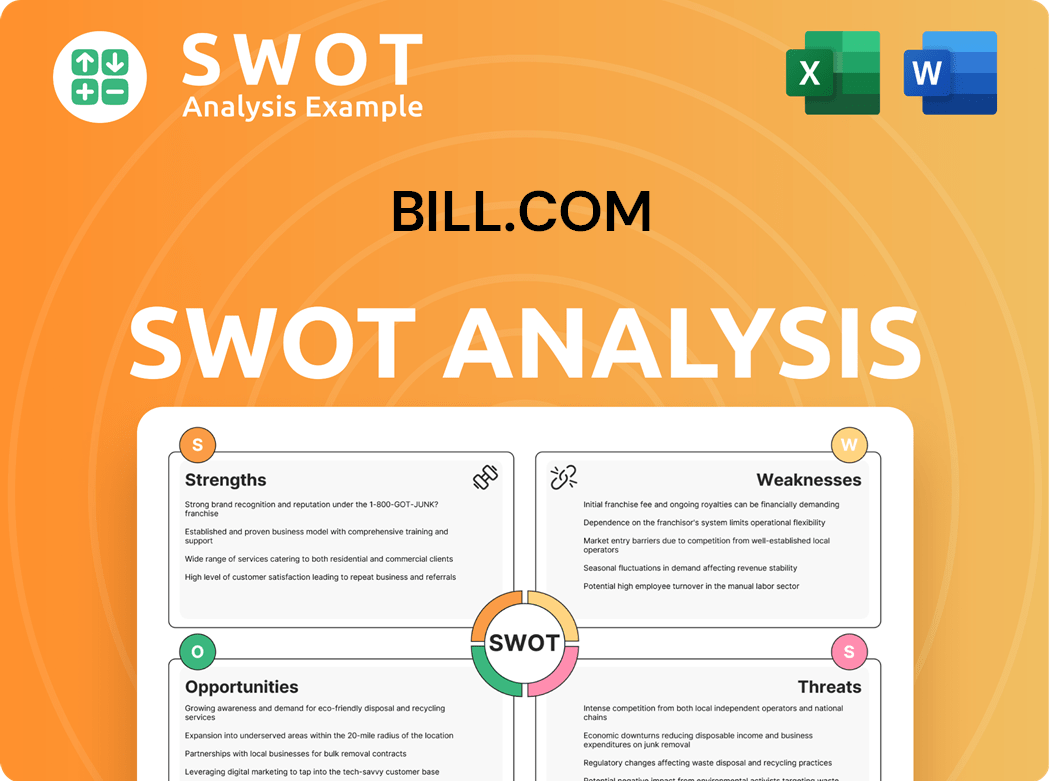
What Drove the Early Growth of Bill.com?
The early growth of the Bill.com company focused on refining its core accounts payable and receivable services, which launched in 2007. Initial funding came through venture capital, including an $8.5 million Series A round. This early period saw significant market traction, with the company reaching an annual payment volume of $10 billion by 2013, highlighting increasing adoption among small and medium-sized businesses (SMBs).
A key development was the 2015 partnership with CPA.com, which expanded its reach by connecting with accounting professionals serving SMBs. This collaboration helped solidify its position within the accounting ecosystem. The company also expanded its team and product offerings, relocating its headquarters from Palo Alto to San Jose, California, in early 2020.
Acquisitions played a crucial role in fueling growth and diversifying capabilities. In June 2021, the company acquired Divvy for $2.5 billion, integrating expense management software. This was followed by the acquisition of Invoice2go in July 2021 for $625 million, enhancing invoicing solutions. The most recent acquisition was Finmark in November 2022, a financial planning and forecasting solution.
By the first quarter of fiscal year 2025, the company served approximately 476,200 businesses. It processed $80 billion in total payment volume and 29 million transactions in Q1 FY2025. Total revenue increased by 18% year-over-year to $358.5 million, with core revenue rising by 19% to $314.9 million, demonstrating continued strong growth.
The company's Q1 FY2025 performance highlights its ability to adapt to the competitive fintech landscape. The increase in total payment volume and revenue reflects growing demand for its services. These figures underscore the company's strategic enhancements and market reach expansion.
Bill.com PESTLE Analysis
- Covers All 6 PESTLE Categories
- No Research Needed – Save Hours of Work
- Built by Experts, Trusted by Consultants
- Instant Download, Ready to Use
- 100% Editable, Fully Customizable
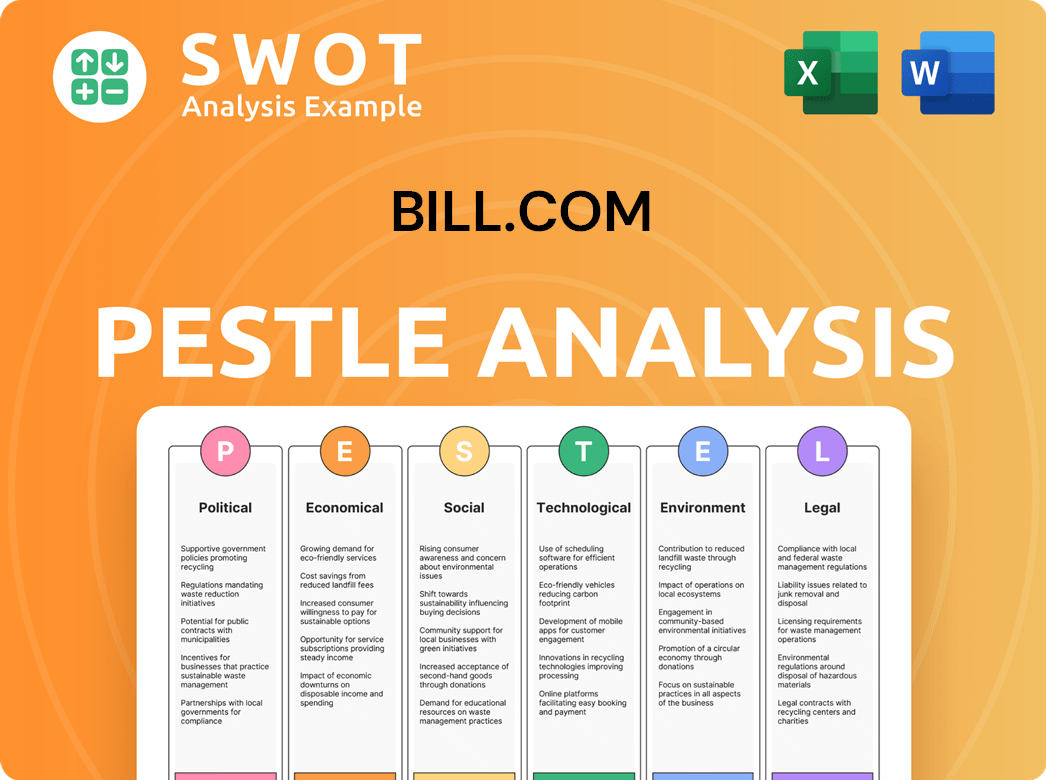
What are the key Milestones in Bill.com history?
The journey of Bill.com, a prominent player in the financial technology sector, is marked by significant milestones that have shaped its growth and market position. From its inception, the Bill.com company has focused on automating financial operations for small and medium-sized businesses (SMBs). The company's evolution reflects its commitment to innovation and strategic expansion within the fintech landscape.
| Year | Milestone |
|---|---|
| 2006 | Bill.com was founded, marking the beginning of its journey to revolutionize financial operations for SMBs. |
| 2019 | The company's Initial Public Offering (IPO) on the New York Stock Exchange in December raised approximately $216 million, fueling further expansion and strategic acquisitions. |
| 2024-2025 | Bill.com continues to enhance its platform with new features and partnerships, focusing on streamlining financial workflows and expanding its market reach. |
Bill.com has consistently introduced innovative features to enhance its platform and meet the evolving needs of its customers. A key focus has been on leveraging technology to automate and streamline financial processes, making them more efficient and user-friendly. These innovations have solidified Bill.com's position as a leader in the fintech space.
The development of a cloud-based platform to automate accounts payable and receivable was a pioneering move, transforming SMB financial operations. This platform provided a centralized solution for managing invoices, payments, and financial reporting, significantly reducing manual work and improving efficiency.
In October 2019, Bill.com expanded its offerings to include new capabilities tailored for mid-market companies. This expansion allowed larger businesses to automate their AP/AR functions, enhancing their financial workflows and improving operational efficiency.
Recent innovations in 2025 include new procurement capabilities, allowing businesses to manage, approve, and track purchase orders with greater precision. This feature streamlines the procure-to-pay process, offering businesses more control over their spending and improving financial oversight.
Bill.com is leveraging AI to streamline procure-to-pay workflows, aiming to reduce manual work and boost efficiency within a single workspace. This integration of AI enhances automation, reduces errors, and accelerates financial processes.
Bill.com introduced Bill Multi-Entity, enabling businesses and accounting firms to manage payments across multiple organizations from a centralized platform. This feature simplifies financial management for businesses with complex organizational structures.
The company is enhancing its mobile accounting experience with streamlined payment processes, more payment options like Pay by Card and Faster ACH, and direct access to Instant Transfer and Invoice Financing within the app. This enhances accessibility and convenience for users managing finances on the go.
Despite its achievements, Bill.com faces several challenges in the competitive fintech landscape. The company must navigate intensifying competition and evolving market dynamics. For a deeper dive into Bill.com's strategic approach, consider reading about the Growth Strategy of Bill.com.
The fintech sector is highly competitive, with numerous players vying for market share in the SMB segment. Bill.com must continuously innovate and differentiate its offerings to maintain a competitive edge.
Macroeconomic factors, including muted spending trends in the SMB sector, can impact customer growth and monetization rates. The company must adapt to changing economic conditions to ensure sustained performance.
Challenges in international payments due to currency volatility and managing the impact of seasonal growth in lower-monetization products like checks and ACH transactions have also been noted. Addressing these challenges requires strategic financial planning and risk management.
In response to these challenges, Bill.com has implemented a multi-faceted growth strategy, making significant investments in product development, improving supplier experiences, and forging new partnerships. The company's strategic partnerships, such as the extended collaboration with Bank of America, underscore its efforts to strengthen its market position and overcome competitive pressures.
Through restructuring efforts and continuous innovation, Bill.com aims to maintain its leadership and drive sustained growth. This involves ongoing adaptation and improvement to meet market demands and stay ahead of competitors.
Bill.com's financial performance and market share are key indicators of its success and ability to overcome challenges. The company continually strives to enhance its financial results and expand its market presence.
Bill.com Business Model Canvas
- Complete 9-Block Business Model Canvas
- Effortlessly Communicate Your Business Strategy
- Investor-Ready BMC Format
- 100% Editable and Customizable
- Clear and Structured Layout
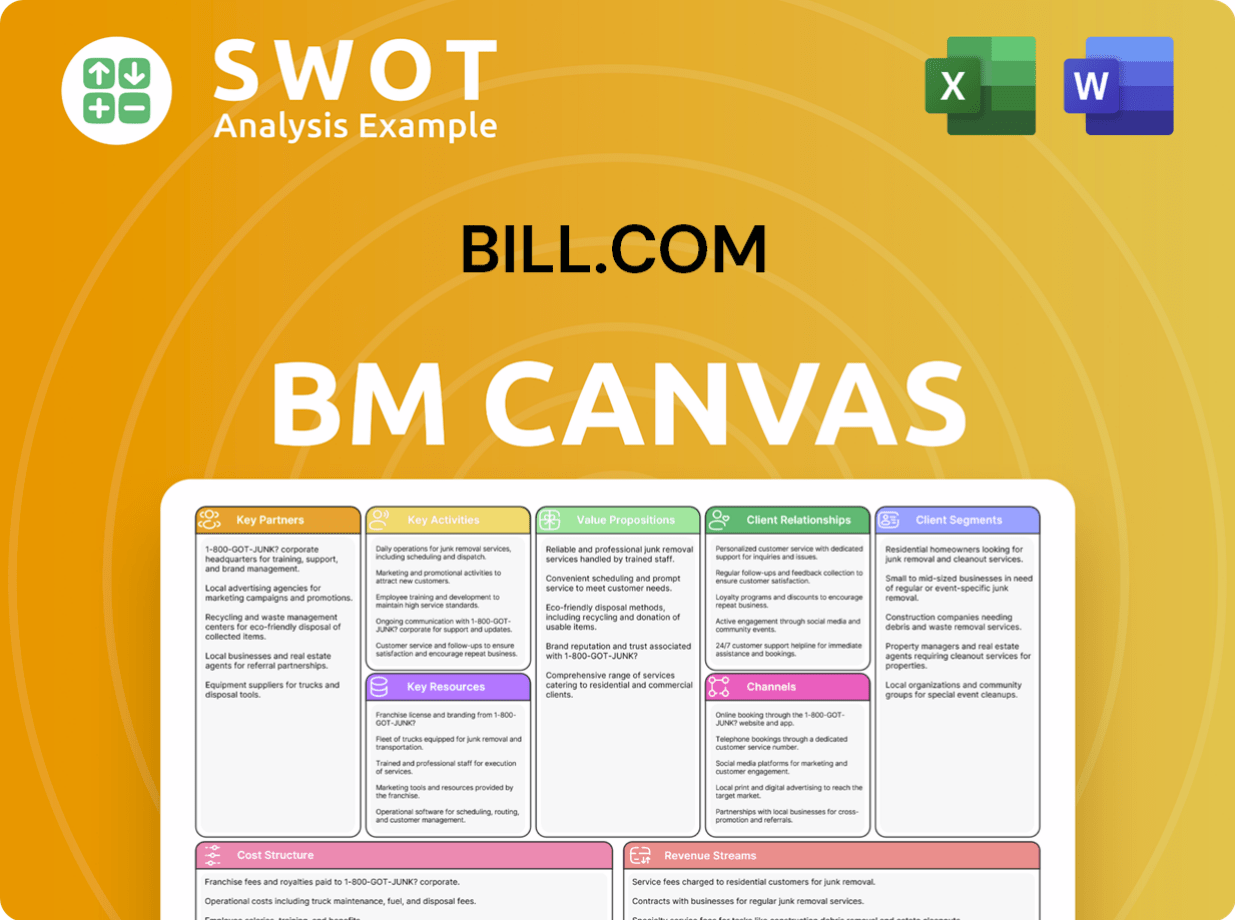
What is the Timeline of Key Events for Bill.com?
The journey of the Bill.com company, from its inception to its current standing, showcases a commitment to innovation and strategic expansion within the financial technology sector. Founded in April 2006 as Cashboard, Inc., by René Lacerte, the company quickly secured its initial funding and launched its platform in 2007. Key milestones include reaching $10 billion in annual payment volume by 2013, partnering with CPA.com in 2015 to broaden its reach, and its Initial Public Offering (IPO) on the New York Stock Exchange (NYSE: BILL) in December 2019. Further growth was fueled by acquisitions, including Divvy in May 2021 and Invoice2go in July 2021. By March 2024, the company served 464,900 businesses, demonstrating its significant market presence and continued expansion, which is a testament to the company's enduring impact on the financial technology landscape.
| Year | Key Event |
|---|---|
| April 2006 | Founded as Cashboard, Inc. by René Lacerte in Palo Alto, California. |
| 2007 | Platform launch and Series A funding of approximately $8.5 million. |
| 2013 | Reached $10 billion in annual payment volume. |
| 2015 | Partnered with CPA.com, expanding its reach to accounting professionals. |
| December 2019 | Completed its Initial Public Offering (IPO) on the New York Stock Exchange (NYSE: BILL). |
| Early 2020 | Moved headquarters from Palo Alto to San Jose, California. |
| May 2021 | Acquired Divvy for $2.5 billion. |
| July 2021 | Acquired Invoice2go for $625 million. |
| November 2022 | Acquired Finmark. |
| March 2024 | Served 464,900 businesses. |
| August 2024 | Announced a $300 million share repurchase program. |
| November 2024 | Reported Q1 FY2025 total revenue of $358.5 million, an 18% increase year-over-year. |
| February 2025 | Reported Q2 FY2025 total revenue of $363 million, up 14% year-over-year. |
| April 2025 | Expanded into procurement capabilities and introduced AI-driven features. |
| May 2025 | Reported Q3 FY2025 total revenue of $358.2 million, an 11% increase year-over-year. |
The company is prioritizing investments in AI-driven automation to improve back-office operations for small and medium-sized businesses (SMBs). This focus positions Bill.com at the forefront of technological innovation within financial management. The goal is to streamline processes and enhance efficiency for its users.
A key initiative for fiscal year 2025 involves doubling down on the accountant channel and expanding partnerships with financial institutions and software companies. This embedded strategy aims to integrate Bill.com's services more deeply into existing financial ecosystems, fostering broader adoption and reach.
The company anticipates further revenue growth, with guidance for total revenue between $1.45 billion and $1.46 billion for the full fiscal year 2025. This projection highlights the company's confidence in its continued expansion and market performance, which is based on the financial data from the latest reports.
The company is focused on building a durable, high-growth, and highly profitable business, with a commitment to innovation and market expansion. The ambition to capture over 20% of core Total Payment Volume (TPV) showcases a commitment to long-term growth and market leadership.
Bill.com Porter's Five Forces Analysis
- Covers All 5 Competitive Forces in Detail
- Structured for Consultants, Students, and Founders
- 100% Editable in Microsoft Word & Excel
- Instant Digital Download – Use Immediately
- Compatible with Mac & PC – Fully Unlocked
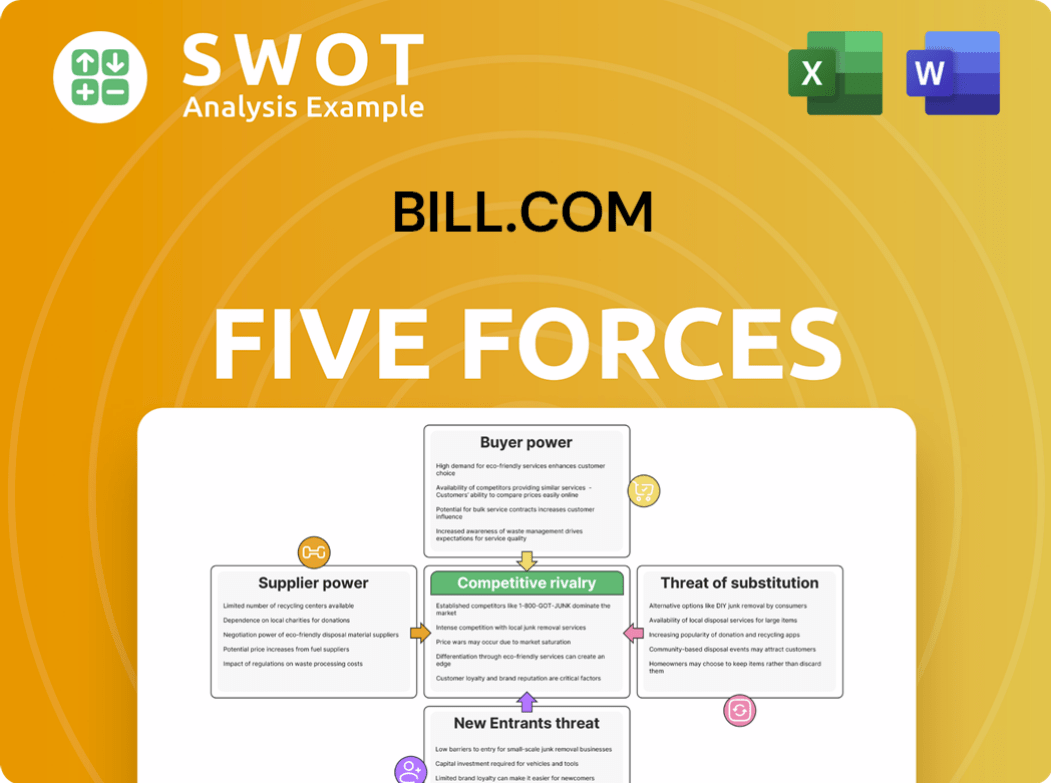
Related Blogs
- What is Competitive Landscape of Bill.com Company?
- What is Growth Strategy and Future Prospects of Bill.com Company?
- How Does Bill.com Company Work?
- What is Sales and Marketing Strategy of Bill.com Company?
- What is Brief History of Bill.com Company?
- Who Owns Bill.com Company?
- What is Customer Demographics and Target Market of Bill.com Company?
Disclaimer
All information, articles, and product details provided on this website are for general informational and educational purposes only. We do not claim any ownership over, nor do we intend to infringe upon, any trademarks, copyrights, logos, brand names, or other intellectual property mentioned or depicted on this site. Such intellectual property remains the property of its respective owners, and any references here are made solely for identification or informational purposes, without implying any affiliation, endorsement, or partnership.
We make no representations or warranties, express or implied, regarding the accuracy, completeness, or suitability of any content or products presented. Nothing on this website should be construed as legal, tax, investment, financial, medical, or other professional advice. In addition, no part of this site—including articles or product references—constitutes a solicitation, recommendation, endorsement, advertisement, or offer to buy or sell any securities, franchises, or other financial instruments, particularly in jurisdictions where such activity would be unlawful.
All content is of a general nature and may not address the specific circumstances of any individual or entity. It is not a substitute for professional advice or services. Any actions you take based on the information provided here are strictly at your own risk. You accept full responsibility for any decisions or outcomes arising from your use of this website and agree to release us from any liability in connection with your use of, or reliance upon, the content or products found herein.